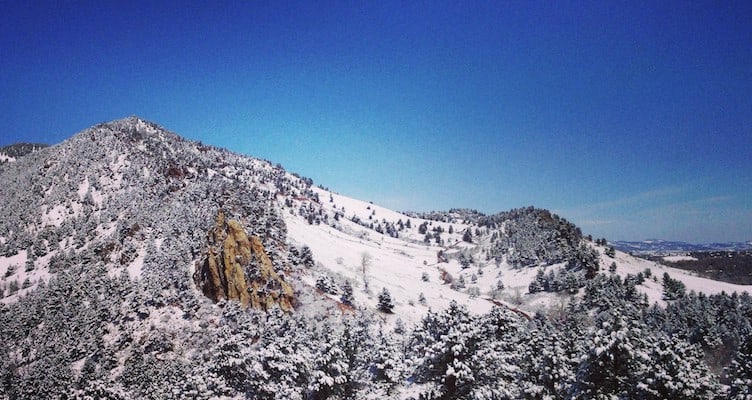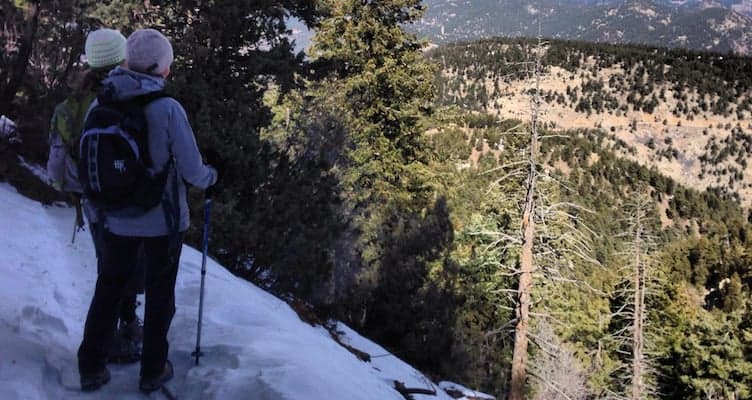
The leaves have fallen and we’ve already enjoyed our first snowstorm. It’s November in Boulder! With each passing day, it seems that fall is slipping away and winter is gaining on us. Some may take one look at those icy trails and pack away their hiking boots till May. But it doesn’t have to be that way! Hiking can be done year-round, by all fitness levels, as long as you’re prepared and have the right gear. Winter hiking is a unique challenge that will test you in ways that 3-season hiking does not. Read on for your comprehensive “how-to” on winter hiking, plus we’ve got a round up of Boulder’s best winter hikes that will keep you moving even as the snow falls and the temperature drops.
What to Wear
Winter in Boulder can mean 60 degrees and sunny or it can means 0 degrees and snowing. And the weather in town is often drastically different from the weather out on the blustery plains or up in the snow-covered peaks. When dressing for a winter hike on the Front Range, it’s wise to prepared for a variety of conditions. This list of items may seem fairly obvious, but it bears repeating. Every year, winter hikers find themselves in perilous situations because they went out onto the trails unprepared for quickly changing weather conditions.
- Lightweight and midweight layers made of breathable, wicking material
- Waterproof outer layer that is easy to move in and easy to pack away if need be
- Warm socks
- Waterproof or water-resistant hiking boots
- Hat and gloves
- Foot traction
The final item in this list is particularly important. Trails in the winter can be snowy, icy, muddy, or a combination of all three. This is the greatest challenge in winter hiking. Invest in at least two pairs of foot traction for slippery trails. Why two pairs when you only have one pair of feet? (1) You’ll be very thankful to have a back-up if the pair you’re wearing suddenly breaks during a hike. (If this happens, most outdoor retail stores will allow you to exchange them, by the way.) (2) Different types of traction work for different conditions. Simple chains are ideal for mixed conditions on flat or rolling trails. Spikes or crampons work best for steeper trails that are predominantly snow and ice. Safety comes first in winter hiking if you want to live to see the next season. Be smart and don’t skimp on these essentials!
What to Bring
When hiking in the summer, we often skip out onto the trails with nothing but a bottle of water in hand. Winter hiking, on the other hand, demands that you come prepared with a few key items for your comfort and safety. Whether you’re planning a short 2-mile jaunt or a daylong trek, remember the old adage, “Better safe than sorry!” Here is a basic list to get you going:
- Plenty of water and snacks as needed
- Extra pair of socks
- Extra pair of foot traction
- Fully-charged cell phone with NOAA weather app
- Water and other supplies for your pet(s) if they are joining you
- A map of the area
- Trekking poles for balance and stability (optional)
- A hiking partner (recommended)
That last one can be a bit controversial in the hiking and mountaineering community. We know that some of you love your solo hikes and climbs, but it goes without saying that having a partner along for the ride is safer than going it alone. This is particularly true in the wintertime. Consider it, especially if you’ll be far out in the backcountry or tackling a daylong trip.
What to Do
Beyond clothing and gear, winter trail conditions and unpredictable weather require you to prepare and react accordingly. Before and during your hike, you’ll want to be mindful of the following:
- ALWAYS let someone know where you’re hiking and when you plan to return (even if you’re with a buddy)
- Don’t bring your pooch if conditions will be uncomfortable for them or if their presence will compromise your ability to look after yourself
- Be alert to weather conditions and the potential for storms
- Check online for seasonal, wildlife, and weather-related trail closures
Where to Go
Hikes for All Levels
These trails are suitable for all fitness levels. The first two have minimal elevation gain and may be snow free for much of the winter. When they do have snow, they are fun and easy to travel. They are particularly well suited for snowshoeing. The third hike is more challenging, but can be cut down into shorter sections for beginners.
Eagle-Sage Loop (2.7 miles): Begin at either the Boulder Valley Ranch Trailhead or the Eagle Trailhead on 51st Street (the latter adds an extra mile of access trail). This gentle circle hike in the northeastern part of town skirts past prairie dog colonies and provides beautiful panoramas of both the foothills and the plains. These trails have an open and airy feel that is perfect for those days when you just need to breathe. The downside is that they can be quite windy, so you may want to save this one for calmer days.
Flatirons Vista Loop (3.6 miles): Begin at the Flatirons Vista Trailhead. This South Boulder gem rolls through both field and forest and features expansive views of the plains and the southern end of the Boulder range, including Eldorado. If you’re looking for a half-day adventure, tack on the adjacent Spring Brook Loop to double your distance. Please note that South Boulder trails are often the first to close due to muddy conditions, so be sure to consult OSMP.org ahead of time.
Mesa Trail (6 miles one-way): Begin at South Mesa Trailhead. The hike begins and ends at the same elevation, but you will have gained approximately 1,400 feet as the trail repeatedly climbs and dips from the open plains of South Boulder into the montane forest zone of NCAR and Chautauqua. You’ll start with a relatively flat stroll, meandering alongside some of Boulder’s historical homesteads. This trail serves as a main thoroughfare for the system, with many other trails intersecting it. Take note of trail signs as you go – it’s easy to get off track if you’re not paying attention. Continue your beautiful journey, rife with a diversity of flora and fauna even in the wintertime, all the way to Chautauqua Trailhead. This one-way hike requires a car drop or pick-up at your destination. Or you may choose to do a shorter hike and go out and back from South Mesa Trailhead.
And One Epic-Level Hike
Feeling pretty badass? Looking for a challenge? A winter climb of Green Mountain will test you, humble you, and reward you with one of the most breathtaking vistas in Boulder. The upper flanks of Green will be snowy and icy for much, if not all, of winter. Once snow falls here, given the elevation and shaded trails, it usually sticks around till spring. Plan accordingly and come prepared for a mountaineering-style experience.
Green Mountain (5.4 miles round trip): This hike begins with Saddle Rock Trail, which starts at the Gregory Canyon Trailhead. The trailhead is currently closed for flood-related repairs, but you may access Saddle Rock via the Baseline Trail out of Chautauqua Trailhead. (This adds a total of 0.8 miles.) Take Saddle Rock up (enjoy the super cool ladder) to EM Greenman to the summit. Complete the summit loop by taking Ranger Trail down the other side. It connects with the west leg of EM Greenman and brings you back to Saddle Rock. Then return the way you came. Spikes or crampons are a must on these trails when snow and ice is present. (Picture from one of my winter ascents below.)
As you can see, winter hiking options in Boulder are plentiful and accessible to everyone. These are only a few suggestions. With our ample Front Range sunshine and 145 miles of open space trails, the possibilities are endless. With preparedness, winter hiking in Boulder can be a wonderful treat and a great way to stay fit throughout the season. Happy (snowy, icy, muddy) trails, Boulderites!





